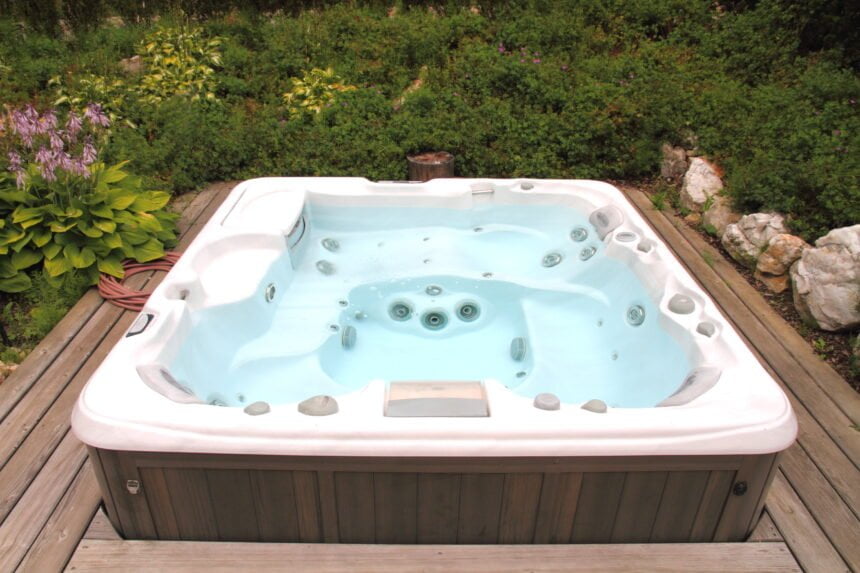Hot tubs offer a blissful retreat, beckoning you to sink into their warm, bubbling waters and let your worries melt away.
It’s no wonder these backyard oases are gaining popularity in the US. Despite the pandemic, the hot tub sales graph saw a positive uptick in 2020. This growth is only expected to rise, despite a fall of 0.5% in 2023, when it was valued at $5.34 billion. The US hot tub market is estimated to increase at a CAGR of 3.41% and reach $7.19 billion by 2030.
Beyond the hype and an indulgent soak, these warm water vessels also provide significant health benefits when used safely and responsibly. So, before you dive in, it’s important to understand both the safety precautions and the potential health benefits that come with owning a hot tub.
Safety Considerations for Hot Tub Use
When it comes to soaking in a hot tub, safety should always be a top priority. Here’s what you need to know to ensure a safe and enjoyable experience:
Setting up Your Hot Tub Safely
Choosing the right location is crucial. Consider the weight of the filled tub, ensuring your chosen spot can handle it.
Remember, electrical access is essential, and you’ll need easy access for maintenance. Always stick to the manufacturer’s procedures for installation and maintenance to avoid any potential risks.
Additionally, ensure you have a GFCI (ground fault circuit interrupter) outlet and proper grounding to prevent electrical hazards.
Maintaining Clean and Safe Water
Proper sanitation and maintaining a balanced chemical level are fundamental for safe use and to prevent health risks like yeast infections.
Chlorine and bromine are common sanitizers, but understanding pH levels and deciding the right sanitizer for your needs is crucial. Test your water on a regular basis using a simple kit, and tweak the chemicals accordingly. This ensures a clean and enjoyable experience and also prevents bacterial growth and skin irritation.
Neglecting water sanitation can lead to potential health risks. Furthermore, dispose of your hot tub water every three to four months to avoid any bacteria buildup.
Safe Soaking Practices
When using your hot tub, remember that time limits are crucial.
The recommended temperature range for hot tubs is typically between 100 °F and 104 °F (38 °C to 40 °C). If you’re hesitant, it’s better to stay on the safer side and start with a lower temperature, gradually increasing it to your preference. Remember to stay hydrated before, during, and after your soak to avoid dehydration, especially in warmer weather.
Finally, avoid getting intoxicated before or during hot tub use, as it can dull your senses and increase the risk of accidents.
Supervision and Precautionary Measures
Never underestimate the importance of supervision, especially if children or elderly individuals are using the hot tub.
Always fasten the cover when the hot tub is not in use to avoid accidents. Hot tub covers help protect against debris, insects, and unwanted access by people or animals.
Furthermore, if you have any ongoing health issues, consult your healthcare provider before soaking in a hot tub.
Health Benefits of Hot Tub Use
Beyond the sheer pleasure of soaking in warm water, certain quality brands like Aqua hot tubs offer a myriad of health benefits that can enhance your overall well-being. Here’s a closer look at some of these advantages:
Relaxation and Stress Relief
The warm water and massaging jets in your hot tub provide a multipronged approach to relaxation. The warmth helps your muscles loosen up, while the jets offer a gentle massage, promoting physical relaxation.
According to the research published in the National Center for Biotechnology Information (NCBI), warm water immersion can even help reduce stress hormones like cortisol, leaving you feeling calmer and more centered. This occurs due to the release of ‘happy hormones’ like dopamine and serotonin.
Complete immersion increases the core body temperature and calms the nervous system. Thus, resetting the circadian rhythm.
Soothing Muscle Pain and Aches
The heat and buoyancy combo due to a hot tub can be incredibly helpful in managing muscle pain and aches. The heat improves blood flow to the impacted area, thus, relaxing the muscle and reducing stiffness.
This can be particularly beneficial for individuals with conditions like arthritis or chronic pain, according to a 2021 study published in the journal Pain Management. However, it’s important to consult your doctor before using a hot tub if you have any prior medical conditions.
Improved Sleep Quality
The correlation between relaxation and improved sleep is well established.
Soaking in a hot tub can help you unwind before bed, and the subsequent decline in your body temperature as you get out can further promote sleepiness. While more research is needed, a 1996 study suggests that using a warm water immersion before bedtime may improve sleep quality in some individuals.
Enhancing Skin Health
Believe it or not, soaking in a hot tub can do miracles for your skin.
The warm water opens up your pores, allowing dirt and impurities to be flushed away. Additionally, the moisture from the steam helps nourish your skin, leaving it tender, glossy, and radiant.
Just be sure to rinse off after your soak to remove any lingering chemicals or contaminants from the water.
In conclusion, hot tubs offer a range of health benefits, from physical pain relief and improved cardiovascular health to mental relaxation and social well-being.
By following proper safety measures and incorporating regular hot tub soaks into your routine, you can enjoy all the advantages they have to offer while safeguarding your health for years to come. Remember, if you have any pre-existing medical conditions, always consult your healthcare professional before using a hot tub.
So go ahead, and partake in a little hydrotherapy—you deserve it!

